Ducati’s ‘winged’ Panigale V4 dominated the hotly contested British Superbike series last year, taking first, second and third in the championship. In World Superbike, Ducati looked unstoppable at one stage. And in MotoGP, if you didn’t have wings, you were effectively bringing a knife to a gunfight. In fact, downforce-generating wings are dominating racing and now the technology is filtering down to the end-user on the road. This is great news for me and you. Not only do they look cool, I discovered they are a huge advantage on the track.
For 2020 Ducati has added its distinctive wings to the Panigale V4 S, further enhancing the beauty and desirability of the Bologna-made masterpiece – as our 2018 Motorcycle of the Year, it is already an astonishing piece of kit. But the wings tell only half the story; the other improvements include updated Evo 2 electronics, revised handling, and easier-to-use power characteristics with lower torque in the first three gears – the bike is much easier to ride fast.
So it was off to Bahrain to test out the new $40,390 (ride away) V4 S around the very fast 5.4km F1 Sakhir track. And yes, it rained, in the desert, where it never rains. But if Ducati is claiming its new V4 S is easier to ride, dare we say more ‘user-friendly’, then what better way to find out than in the wet at 290km/h? Will the clever electronics be able to control a claimed 158kW (212hp) over standing water? It was time to put on those big-boy pants.
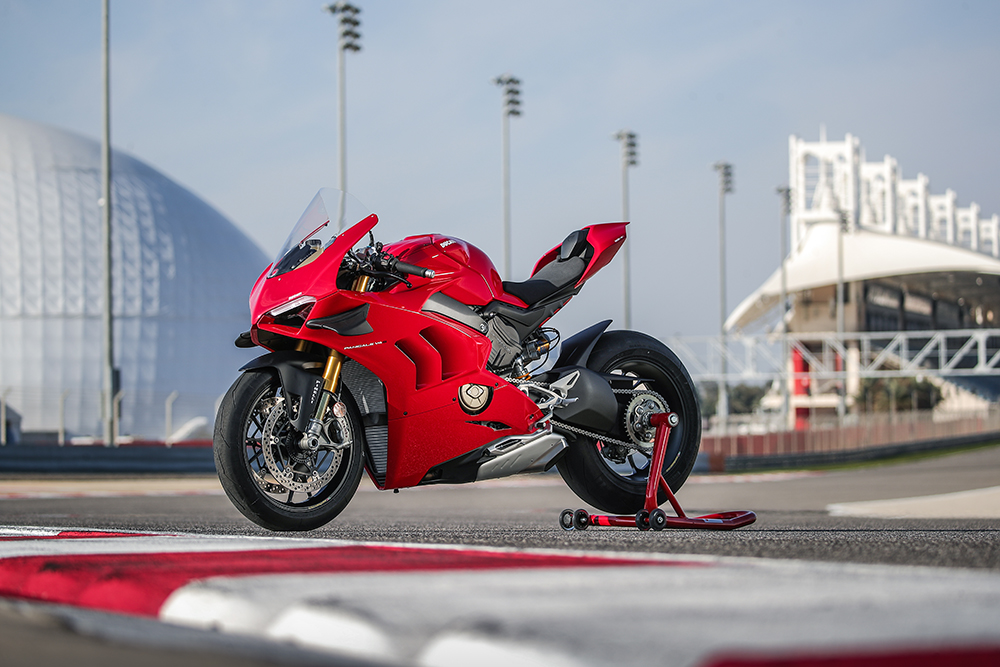
Developed by Ducati Corse, the factory’s MotoGP and World Superbike teams, the 2020 V4 S’s new wings are the same shape and dimensions as those on the WorldSBK and British Superbike Panigales that were so dominant last year. Aside from looking cool and shouting ‘I’ve bought a new Ducati’, they exist to create downforce and are now standard fitment on both the S and the standard model. They are the same as the current R model, carbon fibre construction aside.
Like an aeroplane wing (in reverse) they only make a difference at high speed. At 100km/h they create 4kg of downforce; at 200km/h, 16kg; and at 290km/h, 37kg. Flat out at a restricted 299km/h, you have the weight of a large dog sitting on the front mudguard – kinda like having ET sitting in a basket on the front.
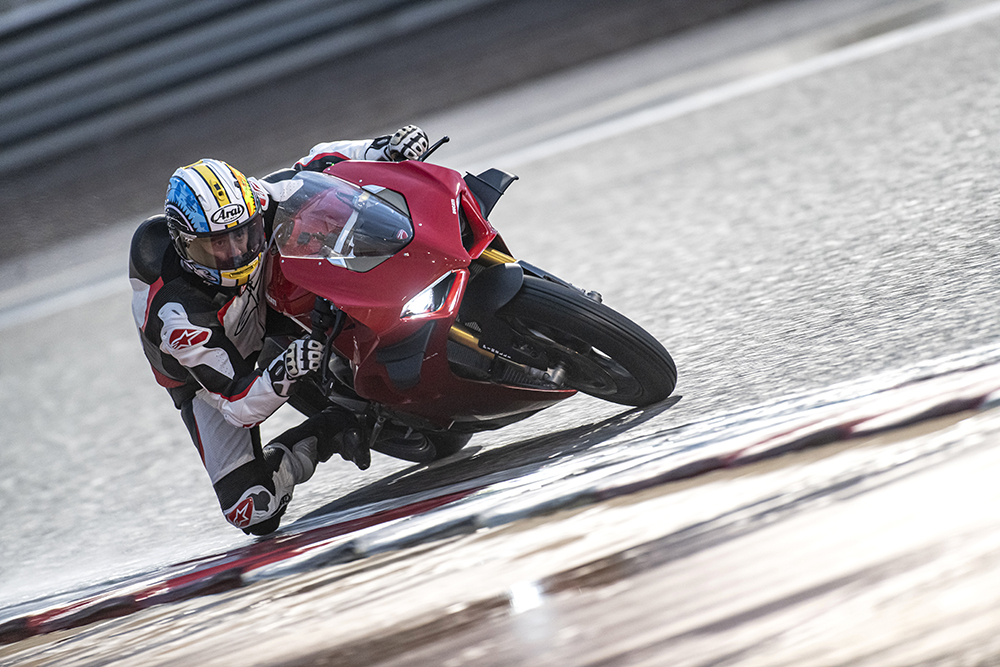
This downforce has several benefits, chief among them a reduction in power wheelies as all that weight is pushed down onto the front end, meaning less electronic intervention by traction control and, for the rider, less rolling off of the throttle. With so much power on a 200hp-plus superbike, it’s hard to control wheelies, especially when you throw a few crests into the mix. Trying to stop a superbike wheelying around any undulating track is a real challenge – one that usually necessitates having to lengthen the wheelbase, use more back brake or roll off the power, either manually or electronically via traction control. All of which ultimately mean a longer lap time.
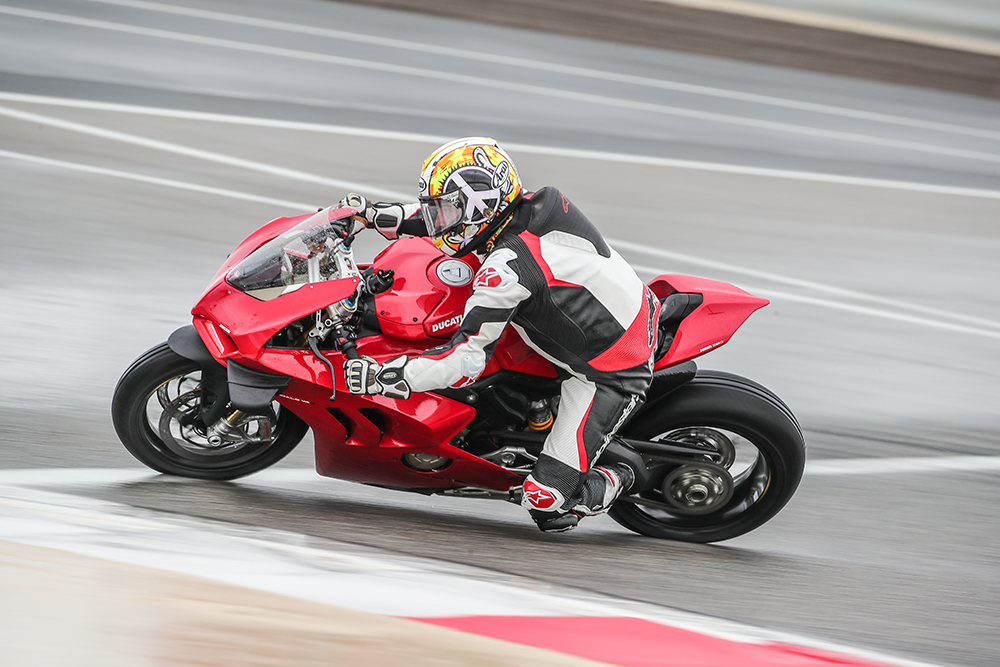
Often at high speeds, a wingless front end can get flighty as the rushing airflow lifts the front, and the rider, who’s holding on for dear life, accentuates the effect by pulling on the ’bars. As speed increases, the fork extends and in extreme situations the shock sits. But wings add downforce, pushing more weight onto the front wheel’s contact patch, giving a more planted feeling while allowing the bike to steer better and hold a tighter line. Well, that’s the theory.
And at the 5.4km racetrack, the wings are admittedly impressive, while stability – even in the wet at 290km/h – is remarkable. There was a slight weave from the ’bars, but this was due more to the movement of the wet tyre at speed than aero. In 160km/h-plus, third-gear corners the Ducati held its line impeccably, understeer completely absent as the front tyre was squashed into the track. I wouldn’t like to think how scary the original V4 S would have been in those conditions without wings.
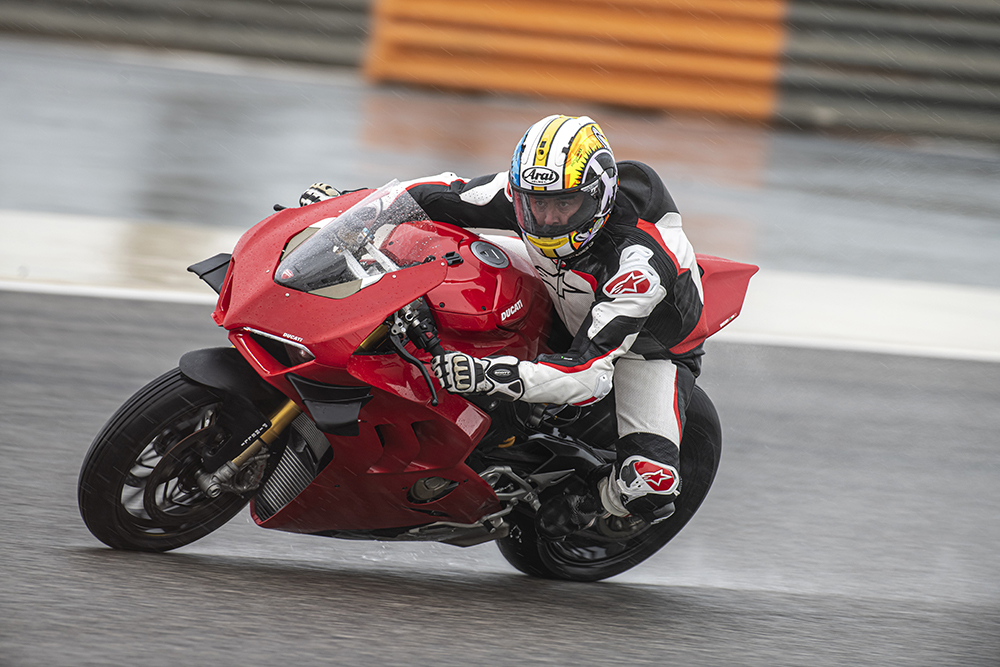
The only downside is drag, which reduces top speed and will increase fuel consumption. However, Ducati has re-thought the bodywork for 2020, making the bike more aerodynamic to compensate, meaning top speed hasn’t been significantly affected. And, frankly, if you’re overly worried about mileage, you’ve bought the wrong bike.
The front fairing is 15mm wider each side, the screen 34mm taller and the sides extend outwards 38mm more than before. The larger fairing gives the rider an easier time; you can tuck out of the wind and it doesn’t feel like you’re going to break your neck at 290km/h. And again, the added bodywork aids the stability as the rider, now cocooned behind a larger screen, isn’t holding on as hard and pulling on the ’bars as they fight the windblast. Ducati has even improved the air-flow around the bike, which should mean the Panigale should no longer cook your ugly bits in summer. This is a big deal in Australian summers – we will test that when the bikes arrive here on Aussie soil.
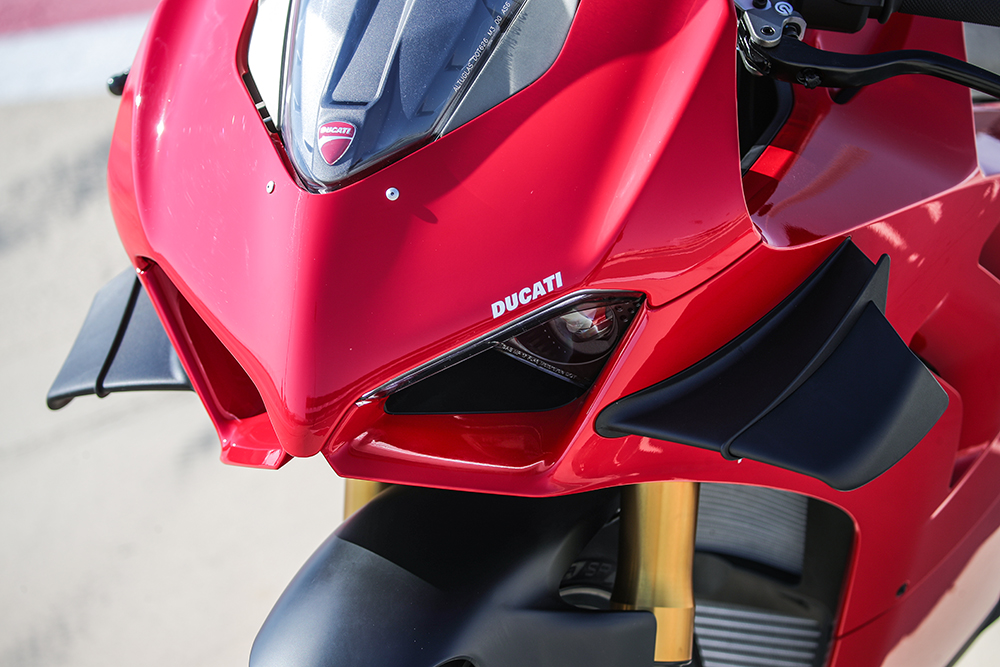
Despite the V4 S’s immense output, wheelies were never an issue on track in the Gulf, albeit on the super-flat surface – though some of this improvement could be down to the new V4’s reduced torque and improved electronic riding aids. Ducati has reduced the Desmosedici Stradale’s immense torque in the first three gears to make the bike more rideable. First and second gear output are the same, then it ramps up in third gear, then it’s full torque in the higher gears.
The four-cylinder Panigale is still quick – the 1103cc 90° V4’s peak power remains at 212hp – but by allowing the rider to get on the power more smoothly and safely in those lower gears, markedly easier too. But don’t be fooled; this doesn’t mean slower – you can get on the power sooner, and without traction control intervention it ultimately means your top speed is higher on the straight and your lap time is reduced with less effort from the rider.
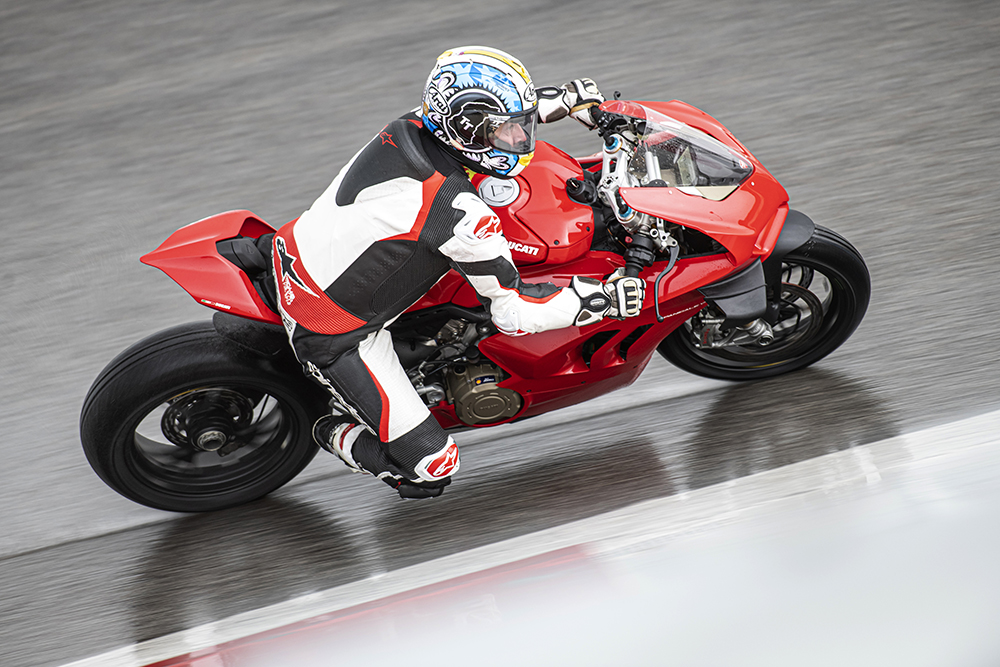
If you’ve ever tried to launch a Ducati V4 S off the line manually without the launch control, it’s like trying to hang onto an angry bull which has just been kicked in the arse. The new V4 S is much more rideable, especially for less experienced riders.
To improve the feel, again to give less experienced riders an easier time, Ducati has derived the front alloy frame from the WorldSBK-spec V4 R, which reduces torsional and braking stiffness. Optimising chassis stiffness is like walking in trainers compared to wooden clogs: you have more feel, there is a closer connection between the front tyre and the rider. The damp conditions during our test amplified this; you could feel the available grip through the front Pirelli.
I’d argue bikes with semi-active suspension can lack front-end feel and on the limit are a little vague, but the Ducati isn’t. Some corners had marginally more grip than others, a fact translated to my brain by subtle but distinct signals.

Although the suspension seems visually the same as before, it’s very different. The bike’s centre of gravity has been raised by 5mm by raising the front by 4mm and the rear shock is 2mm longer with a 5mm longer shock linkage. The rear spring rate is lower and preload is
set higher.
Lifting a bike and raising the centre of gravity allows it to turn easier (it’s easier to fall left or right off a ladder if you’re at the top, as opposed to the bottom). And this simple trick is commonly performed on racebikes at fast, flowing tracks where you want the bike to steer. The plusher rear adds grip and feel in the same way the chassis, mentioned above, has improved the front-end feel.
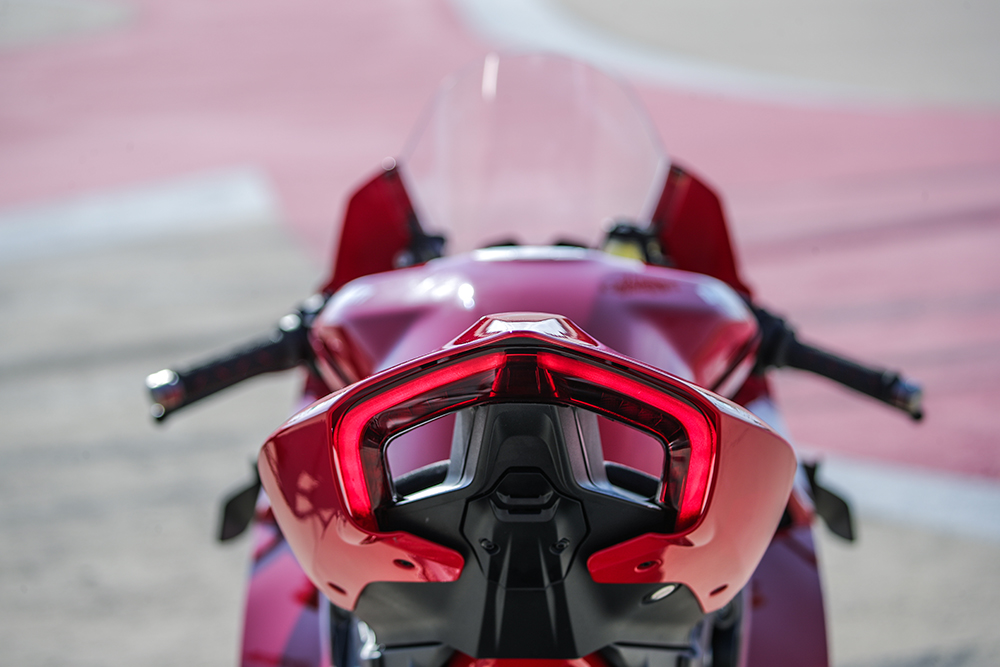
For any rider to ride fast they must have confidence in their bike, know where the limit is, and understand the feeling and level of grip from the tyres – and Ducati has significantly improved this feeling with the new V4 S, the test’s wet conditions a great proving ground. On one long, fourth-gear corner, I could play with the limits, push towards them and feel safe, despite having my knee on the ground. This isn’t just a bike for former racers anymore, a lightweight 212hp superbike shouldn’t be so forgiving and, dare I say, so easy to ride in the wet.
Some aspects of the bike have remained untouched. Ducati has stayed with the same engine spec and layout (producing the same power). The huge Brembo monobloc brakes remain, as does the cast aluminium single-sided swingarm. Other items carried over include the Marchesini aluminium wheels, magnesium headlamp and mirror support and cast aluminium sub-frame. Pirelli Diablo Supercorsa SP rubber comes as standard with a 200/60 section rear.

Those Brembo radial M4.30 brakes are outstanding, the ABS EVO cornering system in partnership with Bosch is almost mind-blowingly effective. End of the straight, just shy of 295km/h, in torrential rain, and it’s time to jump on the stoppers for turn one – a first gear crawl of around 70km/h. It sounds scary, but isn’t – just grab the lever and let the electronics take over. Now for those who remember black and white TV, this might sound crazy, but trust me, they work. You don’t have to work out the grip, simply let the electronics do that job.
Each lap I pushed harder and harder, provoking the grip and feel from the front to the point it was almost comical; on a bike without cornering ABS I would have crashed, I have no doubt, but the Ducati remains unfazed. There is no juddering or pulsing from the lever as you ask for maximum pressure. Instead the system simply provides a little less, which prevents the front from locking. Again there will be riders who say, ‘I don’t need rider aids’ and, yes, there are times when I’d prefer to ride with fewer of them, but the V4 S’s are so good and they rescued me from so many scary situations that I wouldn’t want to be without them.
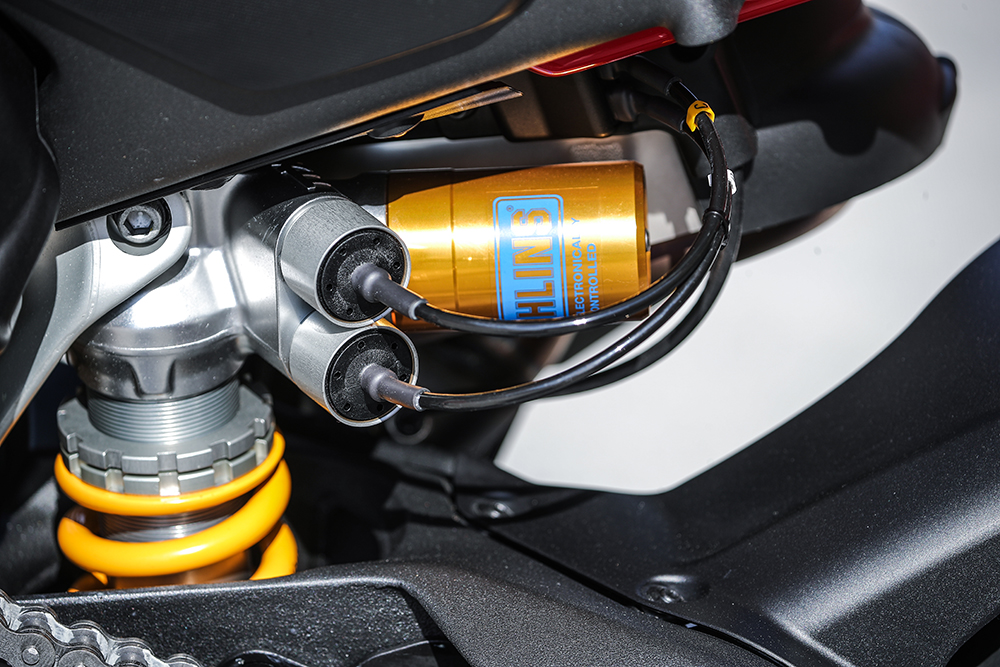
The same can be said for the traction control which has been improved for 2020. The new EVO 2 system, which is similar to the R model’s, is faster and smoother than before. Again, in the damp, you can feel the TC working overtime, but it’s only allowing a fraction less power than you’re asking for to control the slide and spin. In one very wet session it even coped with standing water without too many complaints. Again, Ducati has done this to make the bike more rideable for non-racers. The electronics package and cornering ABS are immensely impressive, some of the best I’ve ever tested and for me one of the major highlights of the 2020 bike.
And remember, these rider aids can be changed on the move, via the three rider modes: Race, Sport, and Street. Each mode alters the power, traction, wheelie and slide control, plus the cornering ABS, engine braking and even suspension damping. With a closed throttle, change the mode, and simply switch over via the toggle on the left bar. It’s not confusing, just straight-forward to use.
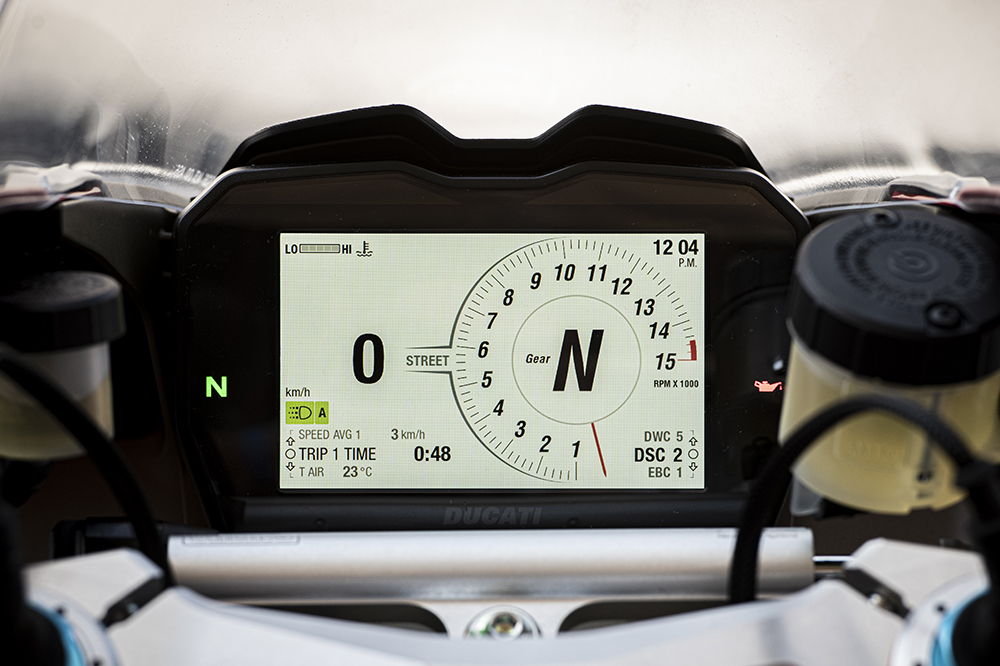
In one session, as the track and grip improved, I changed the pre-set modes, which increased the stiffness in the rear to increase high-speed stability and reduce the rider aids a fraction. I immediately noticed the difference, even these incremental changes, again highlighting how much feedback the stunning new Ducati V4 S gives.
Okay, it was wet, and I would have preferred the dry, but in many ways it was better to test Ducati’s claims of an easier, more forgiving bike for 2020. In back-to-back testing with the now old model, Ducati found that ultra-quick test rider, Michele Pirro, was 0.4s quicker on the new bike, while an average track rider was over a second faster, highlighting how much easier the new bike is to ride. After riding all day until dark, I can confirm the 2020 V4 S is more forgiving and I can certainly see a less-experienced rider lapping quicker, as Ducati found out during its testing.
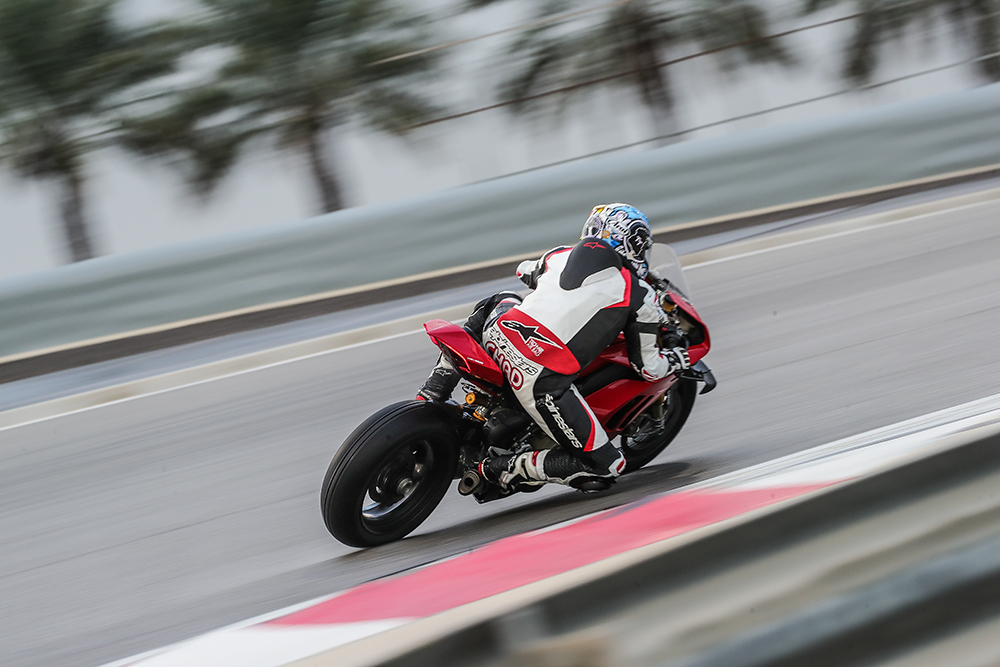
Simply put, the angry Italian stallion has been tamed. It’s now far easier to ride, especially for less experienced riders. This sort of power has never been so easy to manage, and the wet test amplified this.
The Ducati V4 S no longer wants to scare you. It has arguably the best electronics package on any bike on the market and is arguably the most desirable and sexy sportsbike going, too. It’s bloody expensive – but we can’t all be perfect.
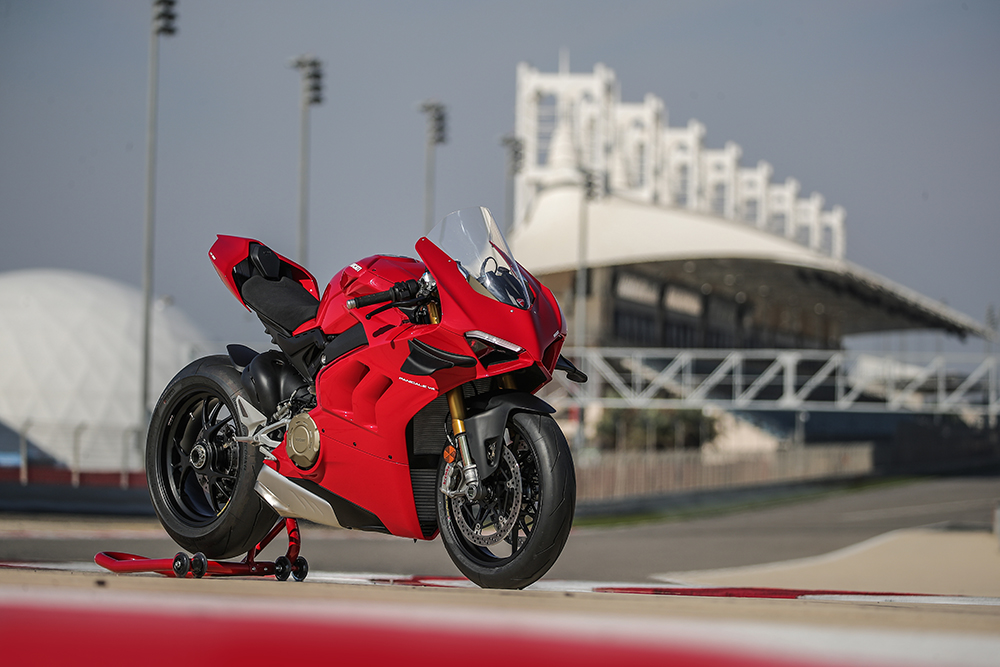
Words Adam Child Photography Milagro











